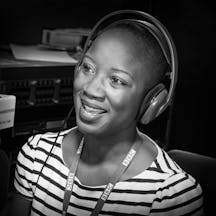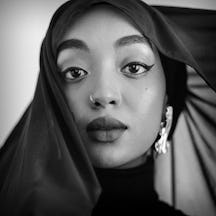The fear of judgement means that many condemn skin bleaching in public while secretly lightening their own complexions. To break away from these taboos and double standards, and to protect people from dangerous products, we need honest information and open conversation.
Enduring taboos and the future of skin bleaching
Words by Ngunan Adamuphotography by Amaal Saidaverage reading time 6 minutes
- Serial

Skin bleaching is a multibillion-dollar industry that draws a lot of attention, both positive and negative. From my conversations on the subject, it’s clear that many from the African and Caribbean communities know that the light-skinned ideal is in part a legacy of colonialism. But even today, this ideal has influenced me and many other Black women through television, where the majority of Black people are still light-skinned, especially musicians and reality-TV contestants.
In 2018’s ‘Love Island’, for example, the one dark-skinned young man featured didn’t last long. This told me and many of my friends that light skin is still more admired than dark skin.
I’ve had the pleasure of interviewing women who use skin-bleaching products for various reasons and women who are against it, but one thing that stood out was the harsh comments from both sides. Those who were against skin bleaching felt that you should be comfortable in your own skin, regardless of what other people say. They believe that women who bleach are insecure, and hate being Black.
On the other hand, the women who bleached said they loved being Black, but their impetus to lighten their skin came from the very community that told them to be happy with who they are, which proved that shadism (colourism) is still alive and kicking.
Irrespective of the reasons both women and men bleach their skin, I would like them to be able to access enough information to make up their minds safely on whether skin bleaching can really give them the lifestyle they want. Your complexion should never define how you are treated or your prospects in life.

Omar, 42: “It’s not a good thing to admit. I thought being lighter would make me look better.”
Treatments of the future
What about skin-bleaching treatments of the future? Growing up in the UK, I knew of the creams and soaps, which are very popular but come with a host of dangers such as chemical burns and mercury poisoning. Through my research, I discovered that the latest methods are Intravenous glutathione treatments and skin-lightening pills. These treatments are very popular in the Philippines, but now have found their way to the UK, America and parts of Africa and the Caribbean.
It’s been said that intravenous skin lightening does not cause uneven skin colour or the dark knuckles that creams can produce, which could make this method more appealing. As Professor Shirley Anne Tate of Leeds Beckett University said to me, “Skin bleaching is only frowned upon if you look like you lighten your skin.”
More: How the wellness industry thrives by making us feel bad.
However, there is no reliable scientific evidence to prove that Intravenous treatments and pills work, so it will be interesting to see whether these treatments can adhere to EU guidelines and be sold openly. The growing popularity of the injections in the US has led to a number of articles on the subject that underline their unproven effects and the possible dangerous outcomes, such as “serious skin disorders, thyroid function impairment and kidney dysfunction”.
When men want to go lighter
For a long time, a lot of the information about skin bleaching has been targeted at women, from the adverts to news of product bans, but a growing number of men are lightening their skin. At a time when we keep talking about loving the skin you are in, it is somewhat surprising to see Black men bleaching.
The most famous skin-bleaching men include Jamaican reggae and dancehall artist Vybz Kartel, who even wrote a song, ‘Cake Soap’, about lightening his skin. There’s also Sammy Sosa, a retired professional basketball player, who started bleaching his skin back 2009 and is open about his treatment.
At a time when we keep talking about loving the skin you are in, it is somewhat surprising to see Black men bleaching.
Last but not least, Nigerian entrepreneur Pela Okiemute has been nicknamed Nigeria’s Hottest Cream Mixer, with a following of over 100,000 people on Instagram, beauty salons in Nigeria, and a list of clients who want to emulate his glow.
With the rise in male grooming, the number of cosmetic products and treatments targeted at men has also risen. This shift in culture indicates that it’s okay for men to look after themselves, and if that means bleaching their skin, then so be it. Ultimately, men’s thinking on the subject is similar to that of women: they want to feel more attractive and gain access to opportunities afforded to those with fair skin. In the Asia-Pacific region it has been estimated that the male cosmetic industry was worth $2.1 billion in 2016.
Bleaching behind closed doors
The media has always portrayed the skin-bleaching industry negatively. For example, back in 2014 I featured skincare entrepreneur Dencia on my BBC radio show when she launched her ‘skin-brightening product’ Whitenicious. She appeared on many media platforms, including Channel 4 and Sky, and every presenter who interviewed her was pretty harsh. So it took me by surprise when in 2018 Whitenicious by Dencia hired Blac Chyna, famous for having a child with Rob Kardashian, to tour and promote the product.
There were a lot of mixed reviews, the majority being negative, with artists such as dancehall artist Grace Hamilton, also known as Spice, coming out to criticise Blac Chyna for making dark-skinned women feel ugly. However, sales for Whitenicious rocketed, which tells me that people feel that they have to openly criticise skin bleaching, yet bleach behind closed doors.
Growing up in the African community in Liverpool as well as travelling all over the world, I have witnessed women from all faiths and backgrounds bleaching, so there’s no prototype or stereotypical-looking Black woman who bleaches. While we criticise these women for wanting to have fairer skin, there are white women tanning and even adopting the so-called Black aesthetic such as darker skin, cornrows, big bums, etc.
This is why I always ask these questions: Why are we in the Black community so hard on each other? Why do we criticise Black women for bleaching when we often see interviews with young Black men saying they’re only attracted to light-skinned girls?
The women that I spoke to all started bleaching before the age of 18 – some as young as 16 – and all were introduced to these products by family members. So it’s heavily ingrained in the African and Caribbean culture, to the point where National Trading Standards is having conversations with churches, mosques and community leaders to help tackle the issue.
For the many reasons I’ve mentioned, Black people are not going to stop lightening their skin, but we need to be more open about the issue. Those who choose to bleach need access to information in order to protect themselves, and we must also break down the taboo that is forcing them to bleach secretly and dangerously.
About the contributors
Ngunan Adamu
Ngunan Adamu is a radio presenter and producer for BBC Radio Merseyside, CEO and founder of iWoman Academy/Media, and an international multimedia trainer for the BBC.
Amaal Said
Amaal Said is a Danish-born Somali photographer and poet, based in London. Her photographs have been featured in Vogue, the Guardian and the New Yorker. In 2017, she was exhibited in Los Angeles, and in 2018 her photography was featured in the fourth volume of African Lens and exhibited in Accra, Ghana.

